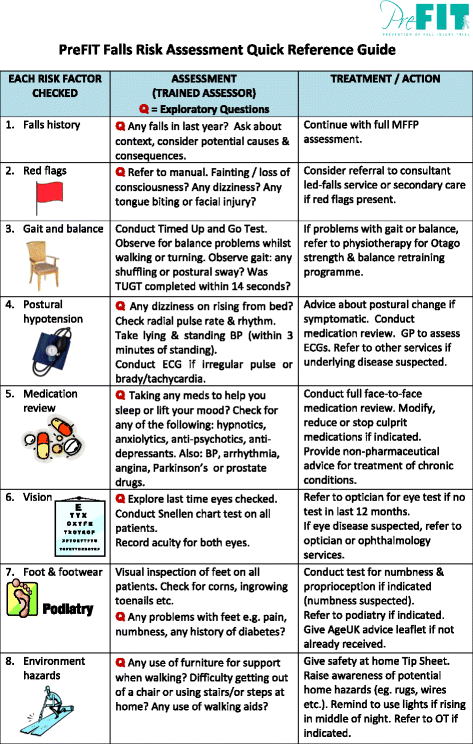Little Known Facts About Dementia Fall Risk.
Some Ideas on Dementia Fall Risk You Need To Know
Table of ContentsGet This Report on Dementia Fall RiskThe Definitive Guide to Dementia Fall RiskThe Buzz on Dementia Fall RiskAll about Dementia Fall Risk
An autumn risk evaluation checks to see just how likely it is that you will fall. It is primarily done for older grownups. The analysis typically consists of: This consists of a series of inquiries regarding your general wellness and if you've had previous falls or issues with balance, standing, and/or walking. These devices test your toughness, equilibrium, and stride (the means you walk).Interventions are suggestions that may reduce your risk of dropping. STEADI consists of 3 steps: you for your threat of falling for your threat variables that can be improved to attempt to stop drops (for example, equilibrium troubles, damaged vision) to lower your risk of falling by using effective approaches (for instance, offering education and sources), you may be asked numerous inquiries consisting of: Have you fallen in the past year? Are you worried regarding dropping?
Then you'll sit down again. Your copyright will examine exactly how lengthy it takes you to do this. If it takes you 12 seconds or even more, it may imply you are at higher threat for a loss. This test checks toughness and balance. You'll rest in a chair with your arms went across over your chest.
Move one foot midway ahead, so the instep is touching the huge toe of your various other foot. Relocate one foot completely in front of the other, so the toes are touching the heel of your other foot.
4 Simple Techniques For Dementia Fall Risk
The majority of drops take place as an outcome of multiple adding variables; for that reason, handling the danger of falling begins with recognizing the elements that add to fall risk - Dementia Fall Risk. Several of one of the most relevant threat aspects consist of: History of previous fallsChronic clinical conditionsAcute illnessImpaired stride and equilibrium, reduced extremity weaknessCognitive impairmentChanges in visionCertain risky medicines and polypharmacyEnvironmental aspects can additionally enhance the threat for drops, consisting of: Inadequate lightingUneven or damaged flooringWet or slippery floorsMissing or damaged hand rails and get hold of barsDamaged or improperly fitted tools, such as beds, wheelchairs, or walkersImproper usage of assistive devicesInadequate guidance of the individuals staying in the NF, consisting of those that show hostile behaviorsA successful fall danger administration program calls for an extensive clinical evaluation, with input from all members of the interdisciplinary team

The treatment plan ought to additionally consist of interventions that are system-based, such as those that promote a risk-free environment (ideal see page lights, hand rails, get bars, etc). The performance of the interventions need to be examined occasionally, and the treatment strategy modified as necessary to mirror changes in the loss danger evaluation. Executing a loss risk administration system making use of evidence-based finest method can decrease the frequency of drops in the NF, while limiting the possibility for fall-related injuries.
The 5-Minute Rule for Dementia Fall Risk
The AGS/BGS standard recommends screening all adults aged 65 years and older for fall threat yearly. This screening is composed of asking clients whether they have fallen 2 or more times in the previous year or sought medical focus for an autumn, or, if they have actually not dropped, whether they feel unstable when strolling.
Individuals that have actually dropped as soon as without injury ought to have their balance and stride examined; those with gait or equilibrium irregularities ought to obtain additional evaluation. A history of 1 autumn without injury and without gait or equilibrium troubles does not warrant further analysis beyond ongoing annual loss danger screening. Dementia Fall Risk. A fall risk assessment is called for as part of the Welcome to Medicare assessment

Rumored Buzz on Dementia Fall Risk
Recording a falls background find more info is one of the quality signs for loss avoidance and monitoring. Psychoactive medications in certain are independent predictors of falls.
Postural hypotension can often be alleviated by reducing the dose of blood pressurelowering medications and/or quiting medicines that have orthostatic hypotension as a side result. Usage of above-the-knee assistance hose and sleeping with the head of the bed elevated might additionally reduce postural decreases in blood stress. The suggested aspects of a fall-focused health examination are received Box 1.

A yank time higher than or equal to 12 seconds recommends high fall risk. The 30-Second Chair Stand examination assesses reduced extremity stamina and equilibrium. Being unable to stand up from a chair of knee elevation without utilizing one's arms indicates boosted autumn threat. The 4-Stage Equilibrium test assesses fixed equilibrium by having the person stand in 4 settings, each gradually more tough.